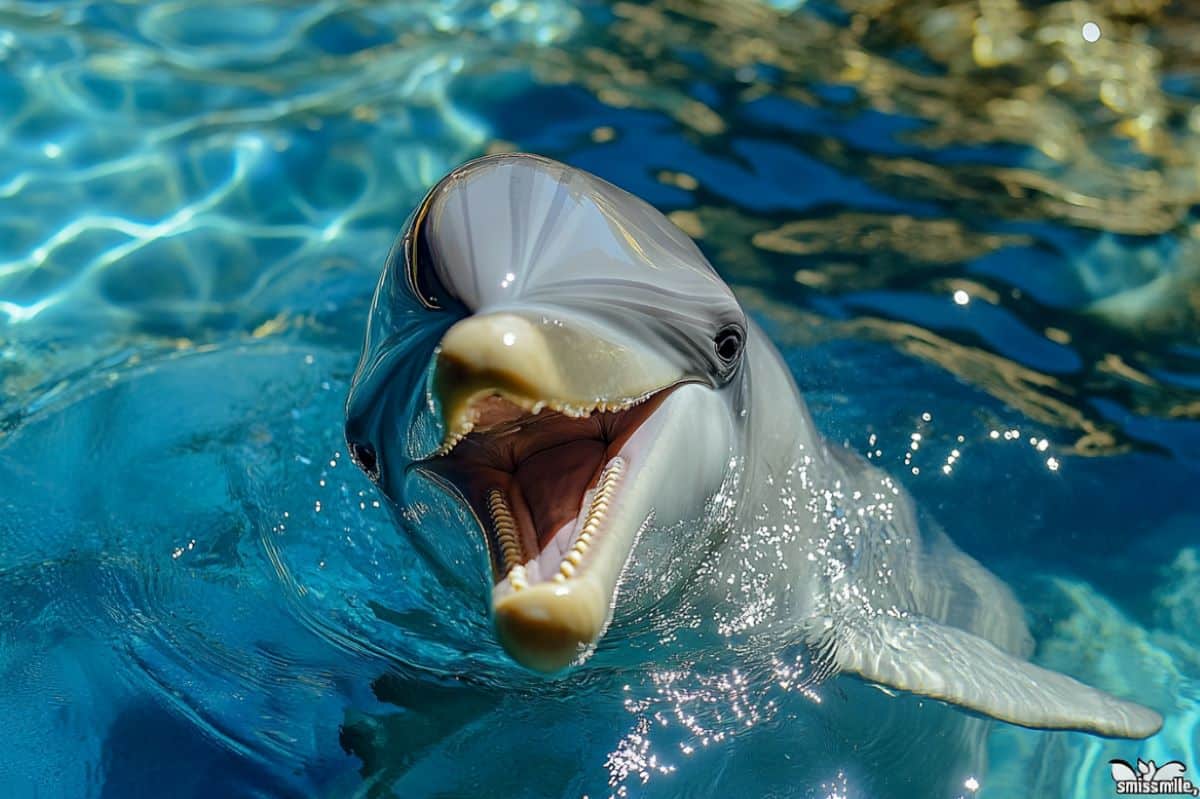Summary: Bottlenose dolphins use an “open mouth” expression, similar to a smile, during playful interactions with other dolphins. This expression is a signal of fun and playfulness, preventing misunderstandings as aggression.
The dolphins use the expression when in each other’s view, and 33% of the time, their playmates mimic the “smile.” Researchers suggest that this form of visual communication is a universal signal of play across many species.
Key Facts:
- Dolphins use an open-mouth expression to signal playfulness during social interactions.
- When one dolphin smiles, the other mirrors the smile 33% of the time.
- This expression helps distinguish playfulness from aggression, fostering cooperation.
Source: Cell Press
Dolphins are extremely playful, but little is known about how they—and other marine mammals—communicate during playtime.
New research publishing October 2 in the Cell Press journal iScience shows that bottlenose dolphins (Tursiops truncates) use the “open mouth” facial expression—analogous to a smile—to communicate during social play.
The dolphins almost always use the facial expression when they are in their playmate’s field of view, and when playmates perceived a “smile,” they responded in kind 33% of the time.

“We’ve uncovered the presence of a distinct facial display, the open mouth, in bottlenose dolphins, and we showed that dolphins are also able to mirror others’ facial expression,” says senior author and evolutionary biologist Elisabetta Palagi of the University of Pisa.
“Open-mouth signals and rapid mimicry appear repeatedly across the mammal family tree, which suggests that visual communication has played a crucial role in shaping complex social interactions, not only in dolphins but in many species over time.”
Dolphin play can include acrobatics, surfing, playing with objects, chasing, and playfighting, and it’s important that these activities aren’t misinterpreted as aggression. Other mammals use facial expressions to communicate playfulness, but whether marine mammals also use facial expressions to signal playtime hasn’t been previously explored.
“The open mouth gesture likely evolved from the biting action, breaking down the biting sequence to leave only the ‘intention to bite’ without contact,” says Palagi. “The relaxed open mouth, seen in social carnivores, monkeys’ play faces, and even human laughter, is a universal sign of playfulness, helping animals—and us—signal fun and avoid conflict.”
To investigate whether dolphins visually communicate playfulness, the researchers recorded captive bottlenose dolphins while they were playing in pairs and while they were playing freely with their human trainers.
They showed that dolphins frequently use the open mouth expression when playing with other dolphins, but they don’t seem to use it when playing with humans or when they’re playing by themselves.
While only one open mouth event was recorded during solitary play, the researchers recorded a total of 1,288 open mouth events during social play sessions, and 92% of these events occurred during dolphin-dolphin play sessions.
Dolphins were also more likely to assume the open mouth expression when their faces were in the field of view of their playmate—89% of recorded open mouth expressions were emitted in this context—and when this “smile” was perceived, the playmate smiled back 33% of the time.
“Some may argue that dolphins are merely mimicking each other’s open mouth expressions by chance, given they’re often involved in the same activity or context, but this doesn’t explain why the probability of mimicking another dolphin’s open mouth within 1 second is 13 times higher when the receiver actually sees the original expression,” says Palagi.
“This rate of mimicry in dolphins is consistent with what’s been observed in certain carnivores, such as meerkats and sun bears.”
The researchers didn’t record the dolphins’ acoustic signals during playtime, and they say that future studies should investigate the possible role of vocalizations and tactile signals during playful interactions.
“Future research should dive into eye-tracking to explore how dolphins see their world and utilize acoustic signals in their multimodal communication during play,” says corresponding author and zoologist Livio Favaro.
“Dolphins have developed one of the most intricate vocal systems in the animal world, but sound can also expose them to predators or eavesdroppers. When dolphins play together, a mix of whistling and visual cues helps them cooperate and achieve goals, a strategy particularly useful during social play when they’re less on guard for predators.”
About this behavioral neuroscience and animal psychology research news
Author: Kristopher Benke
Source: Cell Press
Contact: Kristopher Benke – Cell Press
Image: The image is credited to Neuroscience News
Original Research: Open access.
“Smiling underwater: exploring playful signals and rapid mimicry in bottlenose dolphins” by Elisabetta Palagi et al. iScience
Abstract
Smiling underwater: exploring playful signals and rapid mimicry in bottlenose dolphins
Play is a widespread behavior present in phylogenetically distant taxa that, in its social form, relies on complex communication. Playful communication has been largely neglected in marine mammals.
We focus on playful visual communication in bottlenose dolphins. The open mouth (OM) display was mainly emitted during social than during solitary play and occurred more frequently when the sender was in the receiver’s field of view, suggesting that animals are attentive to the playmate’s attentional state.
Detecting an OM evoked the same facial display in the receiver, a result that strikingly matches with those obtained on cooperative social primates and carnivores. It is difficult to know whether such similarities derive from shared evolutionary pathways (homology) or from evolutionary convergence (homoplasy), as both have been suggested for play behavior.
The pervasive presence of OM and rapid mimicry in the mammal phylogenetic tree indicates the relevance of visual mechanisms in shaping complex communication.






